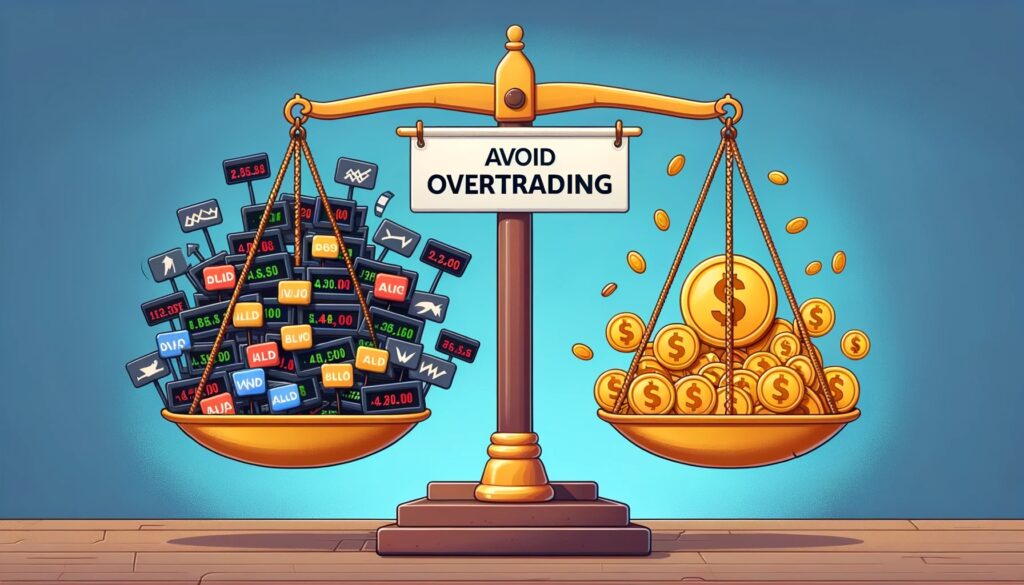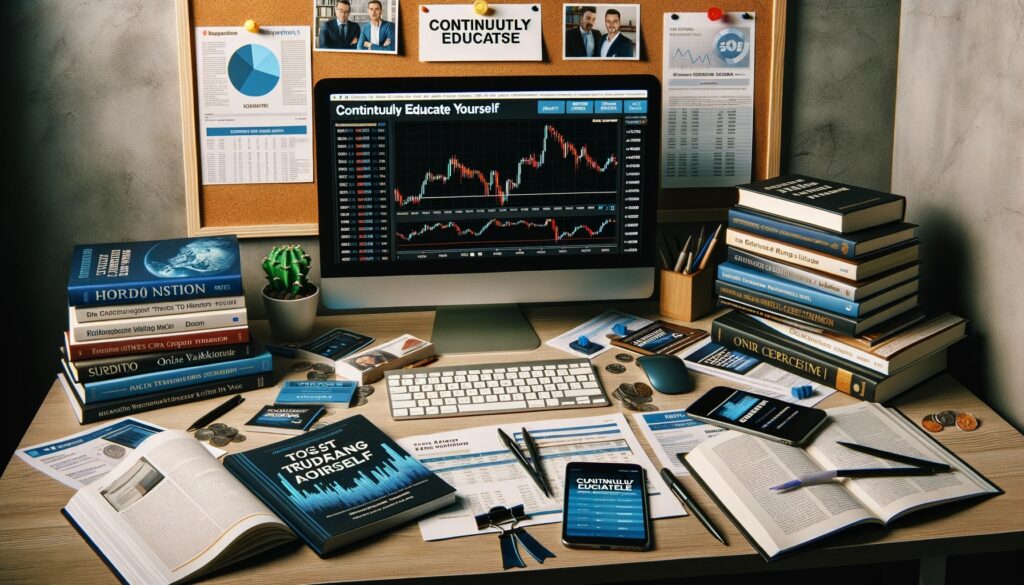In the bustling world of finance, few ventures are as thrilling and rewarding as intraday trading. At WoolyPooly, we’ve not only observed but also actively participated in the dance of numbers that defines this niche. Drawing from our rich tapestry of experiences, we present to you the distilled wisdom of intraday trading rules.
Table of Contents
Understand the Basics of Intraday Trading
Intraday trading, often referred to as day trading, is a trading style where financial instruments are bought and sold within the same trading day. The primary objective is to capitalize on short-term price fluctuations in the market. Traders close their positions by the end of the trading session, ensuring no open positions remain overnight.
Characteristics of Intraday Trading
Short-Term Focus
Intraday traders focus on short-term price movements, often holding positions for mere minutes or hours.
High Frequency
Due to the short-term nature, intraday traders often make multiple trades in a single day.
No Overnight Risks
By closing positions before the market closes, traders avoid potential risks and uncertainties that can occur overnight.
Leverage
Many intraday traders use leverage to amplify their returns. However, this also increases potential losses.
Why Choose Intraday Trading?
Profit Opportunities
The stock market can be volatile, crypto market is extremely volatile, and intraday trading allows traders to profit from both rising and falling markets.
Flexibility
Traders aren’t committed to long-term positions and can adapt quickly to market changes.
No Overnight Exposure
Without open positions at the end of the day, traders don’t face the risk of adverse news or global events affecting their portfolio overnight.
Challenges in Intraday Trading:
Requires Constant Monitoring
The fast-paced nature of intraday trading demands constant attention to market movements and news.
Stressful
Making quick decisions under pressure can be mentally taxing.
Potential for Rapid Losses
Just as there’s potential for quick gains, there’s also a risk of rapid losses, especially when using leverage.
Rule #1 – Solid Trading Plan

The Essence of a Trading Plan
A trading plan is a comprehensive decision-making tool for a trader. It defines what, when, and how much to trade, and under what conditions. Think of it as a roadmap that guides traders through their trading journey, helping them navigate the complexities of the market with clarity and confidence.
Components of a Good Intraday Trading Plan
- Trading Goals: Clearly define what you aim to achieve with your trading. This could be a specific monetary target, a percentage return, or even educational goals for beginner traders.
- Entry and Exit Strategies: Specify the criteria that must be met for you to enter or exit a trade. This could be based on technical indicators, price levels, or specific news events.
- Risk Management: Determine in advance how much of your portfolio you’re willing to risk on a single trade. Setting a fixed percentage can prevent emotional decision-making.
- Money Management: Decide the portion of your capital you’ll allocate to each trade. This helps in diversifying and not putting all your eggs in one basket.
- Trading Schedule: Intraday trading requires time and attention. Define the hours you’ll dedicate to trading and research.
- Review Mechanism: Set aside time to review and analyze your trades. Understand what worked, what didn’t, and areas of improvement.
Importance of a Trading Plan
- Eliminates Impulse Decisions: A well-defined plan ensures that you’re not trading based on emotions or gut feelings, which can often lead to losses.
- Provides Structure: Especially in a volatile market, having a structured approach can be the difference between success and failure.
- Boosts Confidence: Knowing you’re trading based on a well-thought-out strategy can significantly boost your confidence, even when facing losses.
- Facilitates Consistency: Trading is not just about making profits, but about making consistent profits. A trading plan helps in achieving that consistency.
Adapting and Evolving
The financial markets are dynamic, and what works today might not work tomorrow. It’s essential to regularly review and adapt your trading plan based on changing market conditions and personal experiences. This ensures that your strategies remain relevant and effective.
Rule #2 – Prioritize Risk Management

Risk management is the process of identifying, assessing, and mitigating potential losses in trading. In the realm of intraday trading, where market movements can be swift and unpredictable, effective risk management is the linchpin that can safeguard a trader’s capital.
Key Elements of Risk Management in Intraday Trading
- Risk-Reward Ratio: This is a measure of the potential profit of a trade compared to its potential loss. A common rule of thumb is to aim for a risk-reward ratio of at least 1:2, meaning for every potential $1 loss, there’s a $2 potential profit.
- Stop-Loss Orders: These are predetermined price levels at which a trader will sell a security to limit their loss. It acts as a safety net, automatically triggering a sell order when the price drops to a certain level.
- Take-Profit Orders: Similar to stop-loss orders, take-profit orders are set to lock in profits once a security reaches a specified price.
- Position Sizing: This involves determining how much of your capital you’ll invest in a particular trade. By diversifying and not overcommitting to one position, traders can mitigate potential losses.
- Diversification: Even within the scope of a single trading day, diversifying trades across different assets or sectors can spread risk.
Benefits of Prioritizing Risk Management
- Capital Preservation: The primary goal of risk management is to protect your trading capital. Ensuring you live to trade another day is more important than chasing huge profits.
- Enhanced Decision Making: With clear risk parameters in place, traders can make decisions with greater clarity and confidence, free from emotional biases.
- Consistent Trading Results: By managing risks effectively, traders can achieve more consistent results, avoiding the roller-coaster of significant wins followed by devastating losses.
- Long-Term Success: While individual trades might result in losses, effective risk management ensures that traders remain in the game in the long run, paving the way for overall profitability.
Adapting to Market Volatility
Intraday trading often involves dealing with volatile markets. By having a robust risk management strategy, traders can navigate market volatility without incurring significant damage to their portfolios. It’s essential to adjust risk parameters based on market conditions, ensuring that strategies remain relevant and effective.
Rule #3 – Stay Updated with Market News

Intraday trading is a dynamic endeavor where market conditions can shift rapidly. One of the primary catalysts for these shifts is news. From corporate earnings reports to geopolitical events, news can significantly impact asset prices within minutes. For intraday traders, staying abreast of real-time news is not just beneficial—it’s essential.
Types of News that Impact the Market
- Economic Data Releases: This includes data like employment figures, inflation rates, and GDP growth. Such indicators can provide insights into a country’s economic health, influencing its currency and stock market.
- Corporate Announcements: Earnings reports, mergers and acquisitions, and product launches can drastically affect a company’s stock price.
- Geopolitical Events: Wars, elections, diplomatic tensions, and other geopolitical events can influence markets globally, especially commodities like oil and gold.
- Central Bank Decisions: Interest rate changes, monetary policy shifts, and other decisions by central banks can move financial markets, particularly forex and bonds.
- Unexpected News: Natural disasters, technological breakthroughs, or major societal events can have unforeseen impacts on the market.
Tools and Platforms for Staying Updated
- News Websites: Websites like Bloomberg, Cointelegraph, and others provide real-time news updates relevant to traders.
- Economic Calendars: These calendars list upcoming economic data releases, helping traders anticipate potential market movements.
- Social Media: Platforms like Twitter have become crucial for real-time news dissemination, with many journalists and experts sharing instant updates.
- Trading Platforms: Many modern trading platforms come with integrated news feeds, ensuring traders get news relevant to their portfolio.
- News Aggregators: Apps like Feedly allow traders to curate news from multiple sources, ensuring a comprehensive view of market events.
Reacting vs. Overreacting
While staying updated is crucial, it’s equally important to differentiate between news that requires action and noise. Not every news piece warrants a trade. Overreacting to news can lead to impulsive decisions, which might not always be in a trader’s best interest. Analyzing the potential long-term impact of news, even in the fast-paced world of intraday trading, can lead to more informed decisions.
Rule #4 – Master Technical Analysis

Technical analysis is a method used to evaluate and predict future price movements of assets based on historical price and volume data. For intraday traders, mastering technical analysis is paramount. It provides the tools and techniques to make informed decisions, ensuring adherence to the best intraday trading rules.
Why is Technical Analysis Crucial for Intraday Trading?
- Short-Term Predictions: Intraday trading involves making quick decisions based on short-term price movements. Technical analysis offers tools to make these short-term predictions more accurate.
- Objective Decision Making: By relying on charts and indicators, traders can make decisions based on data rather than emotions.
- Identifying Trends: Recognizing the direction in which the market is moving (upward, downward, or sideways) can be invaluable for intraday traders.
Popular Technical Indicators for Intraday Trading
- Moving Averages (MA): This indicator shows the average price of an asset over a specific number of periods. The two most common types are the Simple Moving Average (SMA) and the Exponential Moving Average (EMA).
- Relative Strength Index (RSI): RSI measures the speed and change of price movements and indicates overbought or oversold conditions. An RSI above 70 suggests overbought conditions, while below 30 indicates oversold.
- Bollinger Bands: These bands consist of a middle band (SMA) and two outer bands that are standard deviations away from the middle band. The bands expand and contract based on market volatility.
- Moving Average Convergence Divergence (MACD): This is a trend-following momentum indicator that shows the relationship between two moving averages of an asset’s price.
Chart Patterns to Watch Out For
- Head and Shoulders: This pattern indicates a potential reversal in the market trend and can be either bullish or bearish.
- Double Top and Double Bottom: These patterns signify a reversal in the current trend, indicating potential buying or selling opportunities.
- Triangles (Ascending, Descending, and Symmetrical): These patterns indicate a consolidation in price movements and a potential breakout.
Incorporating Intraday Trading Rules
When using technical analysis, it’s essential to incorporate intraday trading rules. These rules ensure that traders don’t solely rely on indicators but use them in conjunction with other tools and strategies. For instance, while an RSI might indicate an overbought condition, a trader should also consider other factors like market news or major economic announcements before making a trading decision.
Rule #5 – Avoid Overtrading

Overtrading occurs when a trader buys and sells assets more frequently than necessary, often driven by emotions rather than a strategic plan. It’s akin to being on a roller coaster, where the thrill of the ride overshadows rational decision-making. In the context of intraday trading rules, avoiding overtrading is a cardinal principle that ensures sustainability and profitability.
Dangers of Overtrading
- Increased Transaction Costs: Each trade incurs a cost. Overtrading means more transactions, leading to higher brokerage fees and commissions, which can erode profits.
- Amplified Risk Exposure: More trades can mean greater exposure to market volatility, increasing the potential for significant losses.
- Emotional Burnout: Overtrading can be mentally exhausting. The constant stress of monitoring numerous trades can lead to decision fatigue and emotional burnout.
- Capital Depletion: Rapid and frequent trading without a clear strategy can quickly deplete a trader’s capital, leaving them with limited resources for future opportunities.
Signs of Overtrading
- Frequent Trades Without Strategy: If you find yourself entering and exiting positions without a clear rationale or deviating from your trading plan, you might be overtrading.
- Chasing the Market: Trying to capitalize on every minor market movement or constantly trying to recover losses can be indicative of overtrading.
- Ignoring Set Stop-Losses: If you’re consistently overriding or ignoring your predetermined stop-loss points, it’s a sign that emotions, rather than strategy, are driving your decisions.
Incorporating Intraday Trading Rules to Avoid Overtrading
- Set Daily Limits: Determine in advance the maximum number of trades you’ll execute in a day or the maximum capital you’ll use.
- Follow Your Trading Plan: Your trading plan should outline your strategy, including entry and exit points. Stick to it rigorously.
- Regularly Review Trades: Allocate time at the end of each trading day to review your trades. Understanding what drove your decisions can help in identifying and rectifying overtrading tendencies.
- Stay Informed, Not Impulsive: While it’s essential to stay updated with market news, ensure that your reactions are measured and aligned with your intraday trading rules, rather than being impulsive.
Rule #6 – Keep Emotions in Check

Trading, especially intraday trading, is a high-stakes endeavor that can evoke strong emotions. From the exhilaration of a winning trade to the disappointment of a loss, traders are constantly riding an emotional rollercoaster. However, within the realm of intraday trading rules, one principle stands out: the need to keep emotions in check to make rational and profitable decisions.
Why Emotions Can Be a Trader’s Downfall
- Impulsive Decisions: Emotions can lead to hasty decisions, like chasing a losing trade in the hope of recovery or prematurely exiting a potentially profitable one out of fear.
- Overconfidence: A series of successful trades can instill a sense of invincibility, leading traders to take on excessive risks.
- Dwelling on Losses: Conversely, a string of losses can lead to fear and hesitation, preventing traders from seizing good opportunities.
Strategies to Manage Emotions in Intraday Trading
- Adhere to a Trading Plan: A well-defined trading plan, a cornerstone of intraday trading rules, provides a structured approach, reducing the scope for emotional interference.
- Set Realistic Expectations: Understand that losses are a part of trading. By setting realistic profit and loss expectations, traders can better handle the emotional swings of the market.
- Practice Mindfulness and Meditation: Techniques like meditation can help traders stay calm, focused, and maintain clarity in decision-making.
- Limit Exposure: Setting limits on the amount of capital invested in a single trade can reduce the emotional stakes of each transaction.
- Take Regular Breaks: Stepping away from the trading screen, especially after intense sessions, can help reset emotions and provide a fresh perspective.
Rule #7 – Continuously Educate Yourself

The financial markets are in a state of constant flux, influenced by global events, technological advancements, and shifts in economic paradigms. For intraday traders, staying updated isn’t just a recommendation—it’s a necessity. Within the framework of intraday trading rules, continuous education emerges as a pivotal principle, ensuring traders remain agile, informed, and ahead of the curve.
Why Continuous Education is Crucial
- Adapting to Market Changes: Financial markets are influenced by a myriad of factors, from geopolitical events to technological innovations. Continuous learning allows traders to adapt to these changes proactively.
- Enhancing Trading Strategies: As traders gain more knowledge, they can refine and optimize their trading strategies, leading to potentially better outcomes.
- Avoiding Common Pitfalls: By learning from experts and understanding common mistakes, traders can navigate the market with greater caution and foresight.
- Staying Competitive: The world of intraday trading is highly competitive. Continuous education ensures traders maintain an edge over their peers.
Ways to Continuously Educate Yourself
- Online Courses & Webinars: There are numerous online platforms offering courses on trading strategies, technical analysis, and market trends.
- Reading Books: Many seasoned traders have penned their experiences and insights. Books offer in-depth knowledge and a chance to learn from the best.
- Attending Seminars & Workshops: These provide opportunities to interact with experts, ask questions, and gain hands-on experience.
- Participating in Trading Forums: Online forums and communities can be a treasure trove of insights, experiences, and discussions related to trading.
- Staying Updated with News: Financial news websites, journals, and magazines provide a continuous stream of information on market trends and global events.
Continuous education aligns seamlessly with the core tenets of intraday trading rules. While these rules provide a foundational framework, it’s through continuous learning that traders can fine-tune their strategies, adapt to market shifts, and make informed decisions. In essence, intraday trading rules serve as the compass, while continuous education ensures the journey is informed, adaptive, and forward-looking.
Rule #8 – Evaluate and Adjust Your Strategies Regularly

Intraday trading operates in a dynamic environment where market conditions, global events, and economic landscapes are perpetually changing. Relying on a static strategy can be detrimental. Within the framework of intraday trading rules, the regular evaluation and adjustment of strategies emerge as a fundamental tenet, ensuring that traders remain responsive to the market’s ever-evolving nature.
Why Regular Evaluation is Imperative
- Staying Relevant: What worked yesterday might not necessarily work today. Regularly evaluating strategies ensures that traders’ approaches remain relevant to current market conditions.
- Identifying Strengths and Weaknesses: Continuous assessment allows traders to pinpoint what’s working and what’s not, enabling them to capitalize on strengths and rectify weaknesses.
- Mitigating Risks: By adjusting strategies based on recent market trends and personal trading performance, traders can better manage and mitigate potential risks.
- Optimizing Returns: Regular evaluations can lead to strategy enhancements that optimize returns on trades.
Steps for Effective Evaluation and Adjustment
- Review Trade Performance: Analyze the outcomes of recent trades. Were the goals met? If not, what went wrong?
- Analyze Market Changes: Has there been a significant shift in the market? Are there new trends or patterns emerging that weren’t previously considered?
- Gather Feedback: Interact with fellow traders or mentors. Their insights and perspectives can offer valuable feedback on your strategies.
- Backtest Adjusted Strategies: Before fully implementing any changes, backtest the adjusted strategy on historical data to gauge its potential effectiveness.
- Implement Gradually: When adjusting a strategy, consider implementing changes gradually to monitor their impact without overcommitting.
Rule #9 – Choose the Right Trading Platform

The platform serves as the primary interface between the trader and the market, influencing the efficiency, speed, and accuracy of trades. Given the fast-paced nature of intraday trading, the choice of platform can significantly impact a trader’s success.
Factors to Consider When Choosing a Trading Platform
- User Interface: The platform should have an intuitive and user-friendly interface, allowing traders to quickly execute trades, analyze charts, and monitor market movements.
- Speed and Reliability: In intraday trading, seconds matter. The platform should execute trades swiftly and without glitches, ensuring that traders don’t miss out on opportunities.
- Tools and Features: Look for platforms that offer advanced charting tools, technical indicators, and real-time data feeds. These features can enhance decision-making and strategy formulation.
- Security: Given the sensitive financial data involved, the platform should have robust security measures, including encryption and two-factor authentication.
- Costs and Fees: Some platforms charge for access to advanced features or incur higher transaction fees. It’s essential to be aware of these costs and factor them into your trading budget.
- Customer Support: A responsive customer support team can be invaluable, especially when facing technical issues or seeking clarifications.
Integration with Intraday Trading Rules
Your chosen trading platform should align with your intraday trading rules. For instance:
- If your rules emphasize certain technical indicators, the platform should support them.
- If your rules require quick position exits in volatile situations, the platform’s speed and reliability become paramount.
- If your rules mandate regular strategy backtesting, the platform should offer robust backtesting tools.
Recommended Platforms
| Platform | Pros | Cons |
|---|---|---|
| MEXC | User-friendly interface, wide range of cryptocurrencies, lowest crypto exchange fees, advanced trading features | Platform may be complex for beginners, slow customer service response times |
| Binance | Large number of cryptocurrencies, advanced trading features, high liquidity, user-friendly interface | Reports of delayed customer service responses, potential target for hackers |
| Gate.io | Wide range of cryptocurrencies, advanced trading features, user-friendly interface, educational resources for beginners | Higher trading fees, does not support fiat currency deposits or withdrawals |
| OKX | Large number of cryptocurrencies, advanced trading features, competitive fees, user-friendly interface, educational resources for beginners | Reports of account freezes without prior notice, slow customer service response times |
| BingX | Advanced trading features, high leverage, ability to copy trades from successful traders, user-friendly interface | Smaller selection of cryptocurrencies, less liquidity due to smaller user base |
Conclusion
Intraday trading emerges as both an opportunity and a challenge. It’s a realm where split-second decisions can lead to significant gains or losses. But amidst this volatility and unpredictability, intraday trading rules stand as a beacon, guiding traders towards informed and strategic decisions.
These rules, ranging from the foundational principles of understanding market basics to the intricacies of technical analysis, serve as the bedrock for success in intraday trading. They underscore the importance of emotional discipline, the value of continuous education, and the crucial role of the right trading platform. In essence, intraday trading rules are not just guidelines; they are the very framework that shapes a trader’s approach, ensuring that each decision is rooted in logic, strategy, and insight.
But beyond the techniques and tools, the essence of intraday trading lies in the trader’s mindset. It’s about recognizing that the market, with all its opportunities, also carries inherent risks. By steadfastly adhering to intraday trading rules, traders can navigate these risks, optimizing their potential for profits while preserving their capital.
In conclusion, while the allure of intraday trading lies in its potential rewards, it’s the discipline imparted by intraday trading rules that truly paves the way for sustainable success. In this journey of continuous growth and adaptation, these rules serve as the compass, guiding traders towards their financial aspirations.
FAQs
What are intraday trading rules?
Intraday trading rules are a set of guidelines that traders follow to make informed decisions, manage risks, and optimize profits when buying and selling assets within a single trading day.
How do the rules of intraday trading differ from long-term trading?
The rules of intraday trading focus on short-term market movements and require quick decision-making, while long-term trading rules emphasize broader market trends and longer holding periods.
Are there any golden rules of intraday trading I should be aware of?
Yes, the golden rules of intraday trading include: always have a trading plan, prioritize risk management, stay updated with market news, and continuously educate yourself. These rules serve as the foundation for successful intraday trading.
Have there been any new rules for intraday trading introduced recently?
While the core principles remain consistent, new rules for intraday trading can emerge based on market regulations, technological advancements, or evolving trading strategies. It’s essential to stay updated with regulatory bodies and trusted trading communities.
What are the basic rules for intraday trading that every beginner should know?
The basic rules for intraday trading include: setting a clear trading goal, using stop-loss orders to manage risks, not over-leveraging positions, staying informed about market news, and regularly reviewing and adjusting trading strategies.


